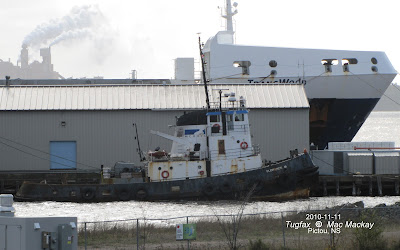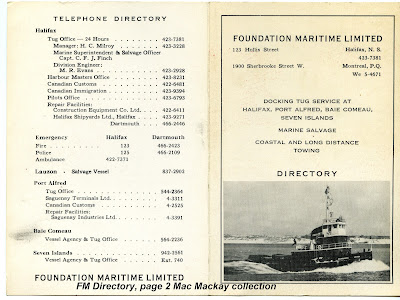The port of Baie-Comeau, QC was developed around the presence of abundant timber and hydroelectric power which lead to building a paper mill, then an aluminum smelter. Foundation Maritime provided tug services with some small tugs, then with the Point Victor (1956) and Point Valour (1958) when they became available. But they were based in Sept-Iles - some distance away. Federal Commerce and Navigation also had a small tug that also worked in Port Cartier.
Cargill, the Chicago-based grain merchants, built a grain storage and export facility in Baie-Comeau to take advantage of Great Lakes ships heading to Sept-Iles, QC to load iron ore. With the opening of the St.Lawence Seaway in 1959 large "Lakers" could bring grain down to Montreal, Trois-Rivières or Quebec City, en route to the iron ore port, but all those ports were closed to shipping in the winter in those days. Cargill's big Quebec City elevators could only export seasonally. A facility in Baie-Comeau could export year round. I believe Cargill wanted a tug full time in Baie-Comeau and therefore opted to build their own. It would also be made available to ships calling for Reynolds Aluminum and the Quebec North Shore Paper Company.
It would be interesting to learn why Cargill decided to go to England for the design and construction of the tug**. It is possible that Canadian shipyards were busy, but it is also likely that the Canadian dollar went much farther in the UK in those days. In any event the British naval architects Burnett-Corliss Partners were engaged to design the tug using their patented "hydroconic" hard chine hull design. But the superstructure design followed that of the Foundation Victor and Foundation Valour's triple decker configuration.
Foundation Maritime was engaged to manage the operation of the tug.
I am also assuming that experience with the single screw Victor and Valour in Baie-Comeau determined that a twin screw tug was better for working in the much tighter quarters in Baie-Comeau. The tug was also reinforced to work in ice.
The P.K.Harris shipyard in Appledore, North Devon, England delivered the Foundation Vibert in 1961. It was powered by two 4 cylinder Fairbanks Morse engines (which were built in the US and shipped to England for installation) giving a total of 1280 bhp* and 20 tonnes bollard pull. The tug was managed from Halifax with crews hired from Halifax, but living in Baie-Comeau. The tug was named after Vibert G. Young a recently deceased Foundation Company of Canada executive and director, and was sponsored by his widow at the launch.
The Foundation Vibert did come to Halifax from time to time (it was called a harbour and coastal tug) for maintenance and a Halifax or Sept-Iles tug would be sent to cover for it, but otherwise it served Baie-Comeau, with occasional assignments in the general area to assist Foundation's salvage busines. It responded to the collision of the Leecliffe Hall and Appolonia in 1964 off St-Joseph-de-la-Rive. Despite best efforts, the Leecliffe Hall sank with the loss of three lives.
Point Vibert with the Smit and Cory shackle and diamond funnel mark, working with a towline and quick release tow hook December 21, 1980.
With the transition from Foundation Maritime to MILTug and Eastern Canada Towing Ltd [ECTUG], the tug was renamed Point Vibert in 1973, but its ownership remained with Cargill and its assignment to Baie-Comeau remained the same.
Point Vibert breaking a skim of ice in Bedford Basin February 20, 1993.Point Vibert at Fairview Cove breaking over night ice which formed around the ConRo Atlantic Concert February 1, 1986.In 1977 Cargill commissioned a new tug, the Voith-Schneider Pointe-Comeau, and when it was delivered the Point Vibert was transferred to Halifax where it became one of the primary harbour tugs for close to ten years under Eastern Canada Towing Ltd ownership. It changed funnel markings as ECTUG changed from Smit and Cory to 100% Cory ownership, eventually losing, then later regaining distinctive gold band at the deck line.
Point Vibert in ECTUG (Cory) colours.
Altough difficult to maintain because of the tire fenders, the gold hull stripe was an attractive feature.
In the mid 1980s ships had become larger and larger and there was demand for more powerful tugs.
ECTUG responded with 4,000 bhp+ ASD tugs and over time the smaller tugs were sold or reassigned. Point Vibert was sent to Point Tupper for a time, but ended up back in Halifax where it remained as a spare tug. When Svitzer Canada took over ECTUG from Svitzer Wijsmuller the tug was offered for sale.
Point Vibert in Svitzer Canada livery.
In 2006 McKeil Marine of Hamilton, ON purchased the tug and renamed it Florence M. They added a towing winch and the tug was used all over eastern Canada, towing barges.
Florence M (right) with another former Foundation / ECTUG tug the Molly M 1 (ex Point Vigour and Foundation Vigour) at Sorel, QC.After the loss of the barge Sault au Cochon off Pictou, NS in 2010 while in tow of the Florence M, the tug was placed in semi-retirement in Hamilton, ON. In 2019 Lakehead Tugboats of Thunder Bay, ON bought the tug in non-operating condition and it was towed from Hamilton, ON to Thunder Bay, ironically, by McKeil's Molly M 1. The former Foundation Vigour and Point Vigour was once the other primary Halifax berthing tug with the Point Vibert.
McKeil fitted the tug with a towing winch, but the tug was underpowered for big barges.
As of December 2021 Lakehead Tugboats were rebuilding the Florence M for a return to service. Once more the fresh waters of Lake Superior will ensure that another former Foundation tug will see many more years of service. It should be quite suitable for shipberthing work at Thunder Bay.
-----------------------------------------------
* Horsepower numbers are approximate at best. Tug operators often used "installed horsepower" and "indicated horsepower" which sounded more powerful than "brake horsepower", but rarely distinguished between them. Due to power losses in clutches and reduction gears, the actual power generated by the engine was reduced by the time it reached the prop. Bollard pull should be a more reliable description of the tug's potential effort if the number is based on recent tests. Bollard pull can "erode" over the years as engines and drive trains lose efficiency however, so even that rating can be inaccurate.
----------------------------------------------
** Update
In 1958 Cargill Grain hired the Foundation Company of Canada and some other contractors to built its grain terminal in Baie-Comeau. Numerous separate contracts were awarded for various aspects of the work, including the construction of a grain storage shed and loading / unloading towers. On August 19, 1960 during the arrival of the first grain cargo, the marine tower collapsed and the storage building caved in. Lawsuits ensued and went all the way to the Supreme Court of Canada. It turns out that Davie Shipbuilding was the contractor hired to build the marine tower, which was essentially a welded steel framework. Foundation, as the general contractor, counter sued adding complexity to the case.
With all the legal issues unsettled it is perhaps little wonder that Cargill did not wish to enter into any new contracts wirth Davie, but was still bound to Foundation with other contracts, such as provision of a tug, which was likely signed before the collapse.
For the record the Cargill / Foundation suit was finally resolved in Foundation's favour when it was found that Cargill's expert engineer had miscalculated the forces that grain would impose on the walls of the storage building. The Foundation Company had built the building following Cargill's engineering, despite expressed reservations about the design. The Supreme Court of Canada finally ruled that Cargill was responsible for the design error and the Foundation Company was not liable for damages.
By coincidence the Supreme Court ruling came in 1977 - the same year that Cargill contracted for a new tug with Eastern Canada Towing Ltd to replace the Foundation Vibert / Point Vibert. The Foundation Company was long out of the picture by then, so there is likely no connection between the two events.
.

































